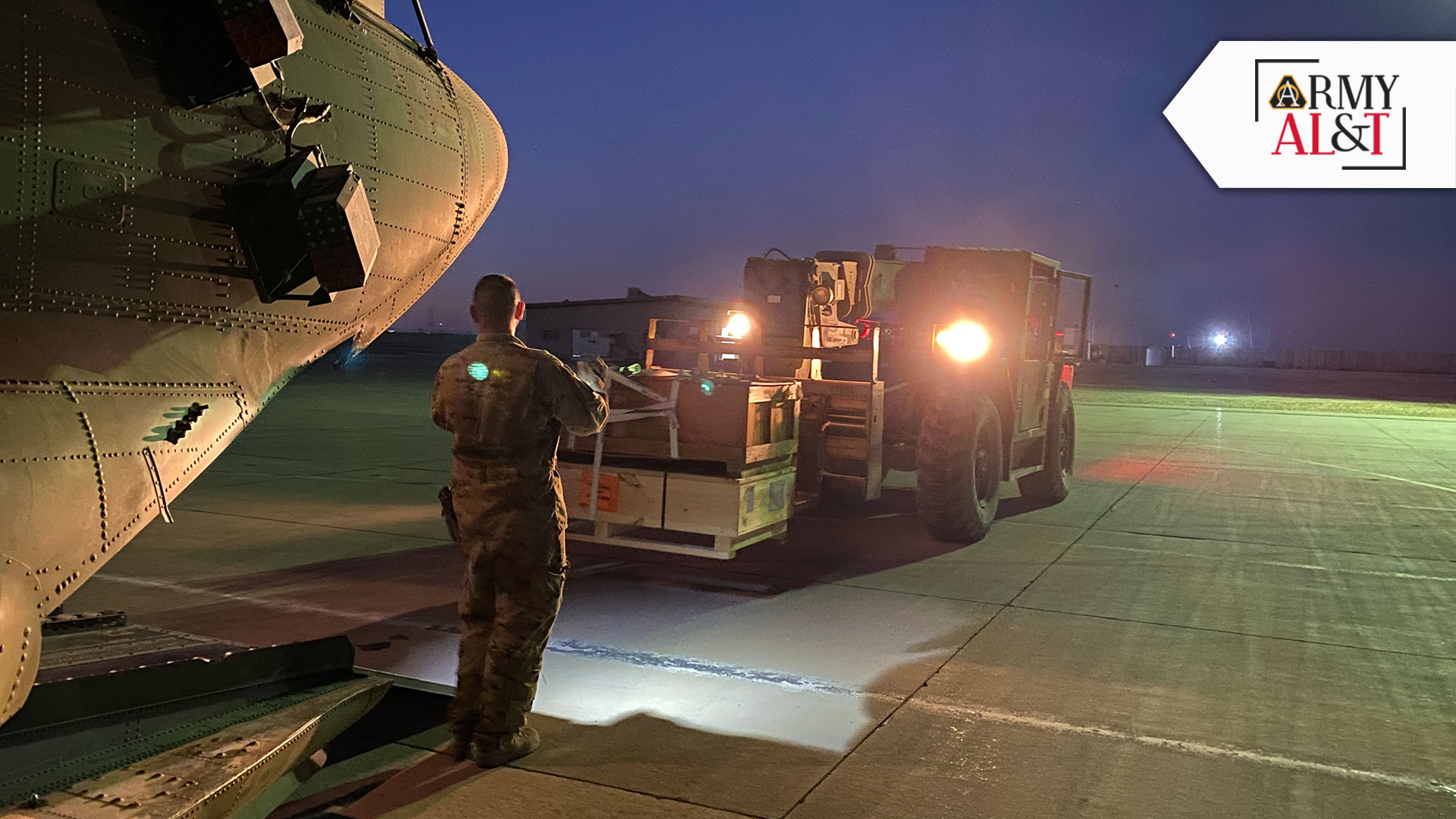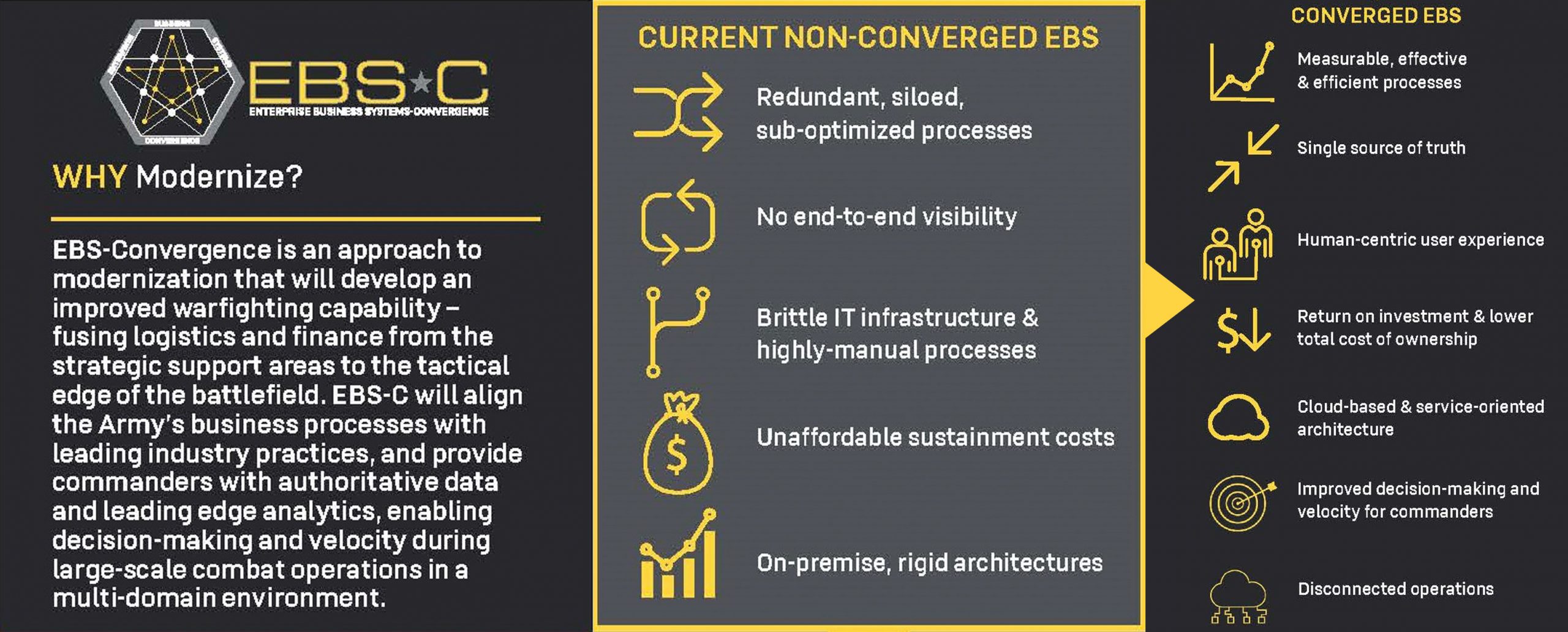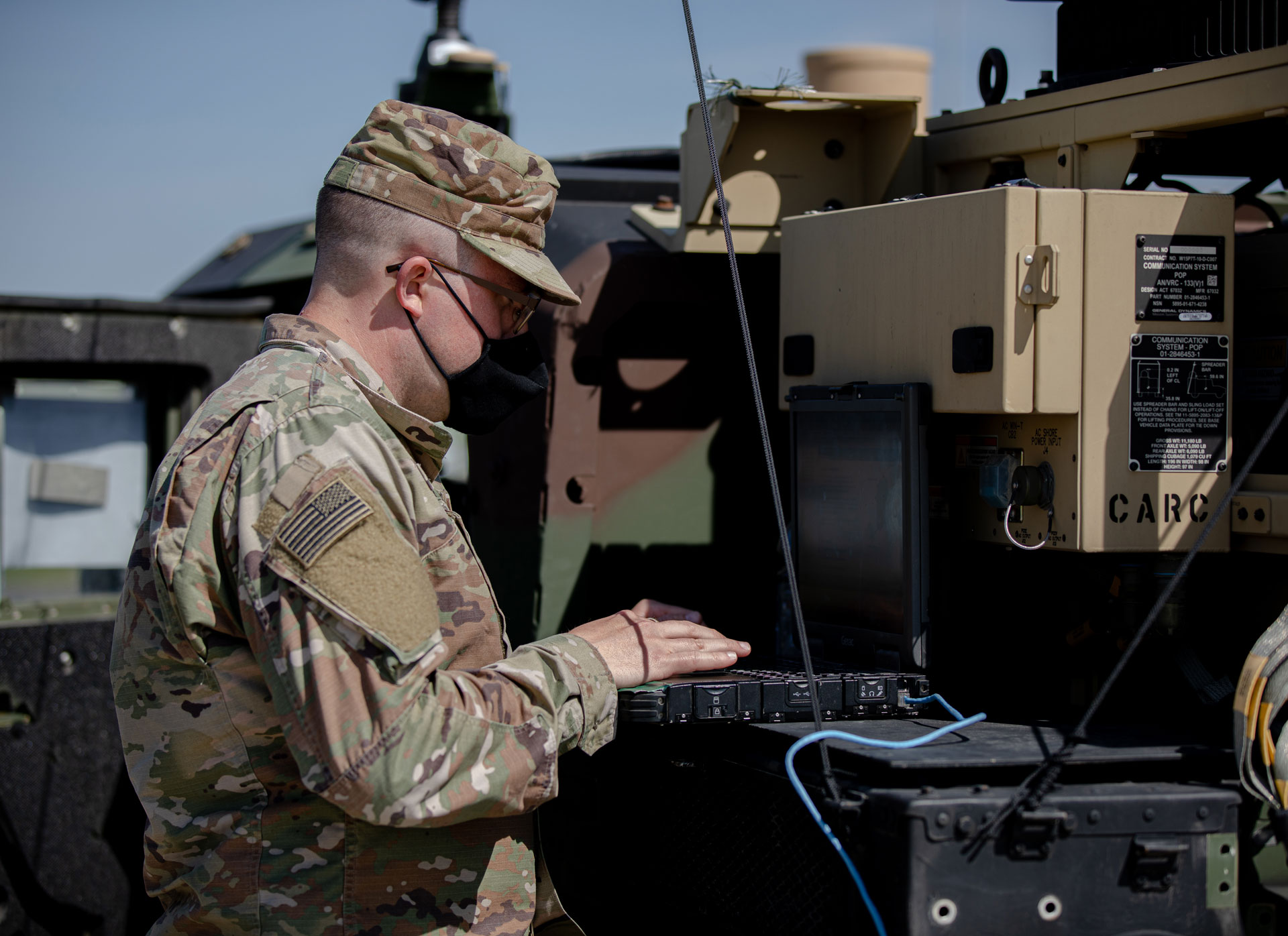
SUPPLY CHAIN IN MOTION: The Army runs on data. EBS-C will enable the Army’s ERPs to more easily share that data, which will in turn provide timely, accurate and readily available data to support the fight. (Photo by Capt. Travis Mueller, 28th Expeditionary Combat Aviation Brigade)
Enterprise Business Systems – Convergence blazes the trail to fusing sustainment and financial systems.
by Brig. Gen. Michael B. Lalor and Ross R. Guckert
“You can ask me for anything you like but time.”
—Napoleon Bonaparte
The Army’s logistics and finance business systems are reaching their end of life, putting us at a crossroads for the next phase of modernization—and it’s coming via Enterprise Business Systems – Convergence. Technology upgrades on the battlefield equip today’s military to fight and win. The time is now to also modernize the Army’s support structure, including enterprise sustainment systems that enable force readiness and lethality.
Globally, the Army has more than 190,000 users on its logistics and financial management enterprise resource planning (ERP) systems. Every day, hundreds of thousands of Soldiers and civilians process 75 million business transactions, managing hundreds of billions of dollars in assets. These platforms interact with and impact every aspect of the Army’s business operations, from ordering supplies in theater to supporting maintenance activities in garrison.
However, the business systems we currently use—while state of the art for their time in the early 2000s—will soon reach their end of life and become unsustainable.
When the Army developed its current ERPs, we allowed business mission areas to customize the systems to meet their own specific needs, in areas like logistics, supply chain and financial management. Because of their separate, customized nature, the systems do not have a single transactional core. Instead, they share information through interfaces that are inefficient. Errors often require a great deal of manual labor to resolve. These inefficiencies delay decision-making and prevent timely allocation of resources.
Having the right equipment at the right time and in the right place matters.
Beyond providing a tactical advantage, employing a system that promotes accurate reporting is critical for the Army to achieve full audit readiness—meaning that the Army fully meets standards that test our ability to properly manage our systems, be accountable for our assets and, most importantly, be good stewards of taxpayer dollars. A converged system will allow the Army to pull more complete data and provide real-time information on the expenditure of funds. We must be able to trace where every dollar is going to ensure we are responsibly managing funds, while enabling Soldiers and civilians to complete their missions.
That is why, in March 2020, the undersecretary of the Army approved a modernization effort called Enterprise Business Systems – Convergence (EBS-C), which is focused on transforming the way our Army does business.

WHY CONVERGENCE? The Army’s current enterprise business systems are not able to efficiently drive readiness, and they do not provide modern capabilities to execute sustainment or fiscal management operations. (Graphic by EBS-C MFCT and EBS-C product office)
WHY WE MUST MODERNIZE NOW
EBS-C is necessary because the Army’s current enterprise business systems are not able to efficiently drive readiness, nor do they provide modern capabilities to execute sustainment or fiscal management operations. For example, one system manages the procurement of parts and associated costs using process A, while another tracks procurement and costs using process B. While the systems talk to each other, they are not completely speaking the same language or tracking things the same way, which affects reporting, inventory, cost management and more. Modernizing Army business systems to track and manage things the same way, in the same “language,” in the same system will streamline sustainment and finance business processes to increase velocity and fidelity of decisions on the battlefield.
EBS-C aims to initially fuse six of the Army’s major ERPs, including:
- General Fund Enterprise Business System (GFEBS), the Army’s largest finance and accounting system.
- GFEBS-Sensitive Activities, the sensitive activities component of GFEBS.
- Global Combat Support System – Army, which supports logistical and tactical management of Army assets.
- Logistics Modernization Program, which facilitates national supply chain management of parts and equipment.
- Army Enterprise Systems Integration Program Hub, the system for master data management.
- Headquarters Army Environmental System, which provides environmental data management and reporting.
The need to support increasingly complex operational requirements for the Army of 2028 provides us with a once-in-a-generation opportunity to transform capabilities, resolve performance gaps and fuse disparate systems into a modernized platform that will more effectively enable multidomain operations in large-scale combat operations.

THE ROAD AHEAD: The EBS-C process will decommission several legacy Army ERPs, through a comprehensive business process overhaul, which will result in modern data systems that speak “the same language” and facilitate smoother transactions. (Graphic by EBS-C MFCT and EBS-C product office)
A DIVERSE, INCLUSIVE TEAM
EBS-C is the largest Army effort ever across the business mission area, engaging leaders and end users in cultivating a user-first environment. It is co-chaired by the assistant secretary of the Army (financial management and comptroller), the Army Materiel Command commanding general, and the Army’s chief information officer. It breaks down into several components that make up the team: the Multi-Functional Capabilities Team, The Army Business Council – Multi-Functional Capabilities Team Working Group, the Army Office of Business Transformation and the EBS-C Product Management Office.
Multi-Functional Capabilities Team
To develop user-centered requirements for a future converged system, EBS-C is driven by a Multi-Functional Capabilities Team (MFCT), which was activated in June 2020. This team includes experts and users from throughout the Army’s business areas, including installations, training, finance, logistics, acquisition and human resources, who were specially assigned to the project to participate in business-process reengineering.
The MFCT is using Agile methodology to analyze current business processes within the different systems and to define what is really needed in the future within one system. Teams of users are participating in “sprints,” or workshops, to define current business processes and to drive requirements for a future solution. Their job is to challenge the status quo—all of the ways that people are used to doing business—in order to focus the Army on what it really needs.
The success of a converged system is dependent upon the ability of system managers to adapt to the changes that are identified through business-process reengineering; soliciting feedback and gaining buy-in has been essential throughout this process. EBS-C includes detailed representation from across the Army Secretariat, Headquarters Department of the Army staff, Army commands and, most critically, users in the field.
Office of Business Transformation
The Army Business Council – Multi-Functional Capabilities Team Working Group, chaired by the director of the Office of Business Transformation, has an advisory relationship to the MFCT. The Office of Business Transformation ‘s role in contributing to the EBS-C effort is inherent in its mission, which is to develop business strategy and policy, enable governance and promote best-in-class business practices to improve efficiency and facilitate innovative solutions and improvements across the Army.
EBS-C Product Management Office
The Program Executive Office for Enterprise Information Systems (PEO EIS) EBS-C Product Management Office (PMO) is charged with the creation of the acquisition strategy, as well as development and deployment of the Army’s modernized and converged ERP system. The PMO will oversee the operational approach and implementation of this modernization, which will ultimately improve how all business is done and reported in a rapidly modernizing Army. The PMO is conducting a wide range of market research to explore the use of modernized acquisition strategies, principles and processes to find the best and most efficient way to make convergence a reality.

NETWORKING IN THE FIELD: EBS-C is seeking ERP commercial off-the shelf software solutions to support 24 major capability areas spanning logistics, supply chain, finance, real property, environmental management and defense operations. It will enable effective weapons and equipment management, maintenance and engineering, and force deployment operations. (Photo by Spc. Giovanny Lopez, 173rd Airborne Brigade)
NEXT PHASE AND NEW OPPORTUNITIES
By 2027, the Army will deploy the converged system, fusing six missions into one, to manage everything from ordering and delivering tank and helicopter parts, to managing costs, to combining and sharing the data needed to win on the battlefield.
To get there, the Army will leverage the capabilities of the private sector to support in the deployment, development and integration of the system. In February 2021, the MFCT and the EBS-C PMO hosted their first industry day. More than 500 industry participants attended virtually to hear how the Army plans to partner with the commercial sector on this significant transformation project.
The pathway to this converged system includes an approach that is “as commercial as possible and as military as necessary,” meaning that we must reap the benefits of industry best practices while providing solutions for military purposes.
The benefits of achieving converged processes that adhere as closely as possible to industry best practices will allow the Army to better plan the movement of goods and financial resources across the battlefield and throughout the operating force.

BUCKLE UP: EBS-C will provide measurable, effective and efficient processes through improved supply chain management and integrated finance, supply, maintenance and transportation processes. (Photo by Spc. Giovanny Lopez, 173rd Airborne Brigade)
THE TIME IS NOW
In any technology-driven business, the drive for improvement is always an imperative. The time for it is always now. That’s no different for the Army.
In an era of great power competition and increased technological complexity, the Army must achieve information superiority and outmaneuver its enemies in order to carry out its mission and win our nation’s wars.
We will do so by modernizing our tools and technology, including our supporting business systems, to develop an information age warfighting capability.
EBS-C is a critical component to the Army’s modernization strategy that combines the different ways we do business into one system. The time to modernize our Army business is now.
For more information about EBS-Convergence, visit https://www.asafm.army.mil/ and https://go.usa.gov/xFTSs.
BRIG. GEN. MICHAEL B. LALOR is the EBS-C MFCT director and the 43rd commandant of the U.S. Army Ordnance Center and School at Fort Lee, Virginia. He holds an M.A. in liberal arts from Louisiana State University; a Master of Military Art and Science from the School of Advanced Military Studies, Command and General Staff College; and a Master of Strategic Studies from the U.S. Army War College, as well as a B.S. in criminal justice from the University of Scranton. He is a seasoned Army leader and logistician with more than 25 years of diverse military service experience in a variety of troop leadership and staff assignments.
ROSS R. GUCKERT is program executive officer of PEO EIS at Fort Belvoir, Virginia. He holds an M.S. in engineering management from The George Washington University and an M.S. in national resource strategy from the Industrial College of the Armed Forces, as well as a B.S. in electrical engineering from the University of Pittsburgh. He is Level III certified in program management; engineering; and science and technology management.







